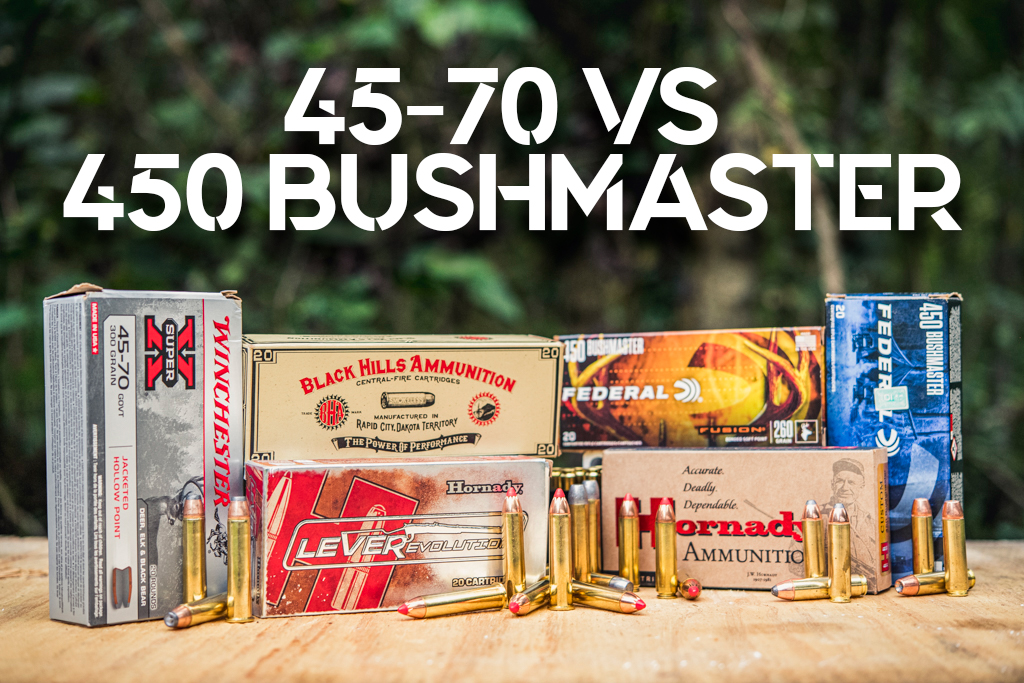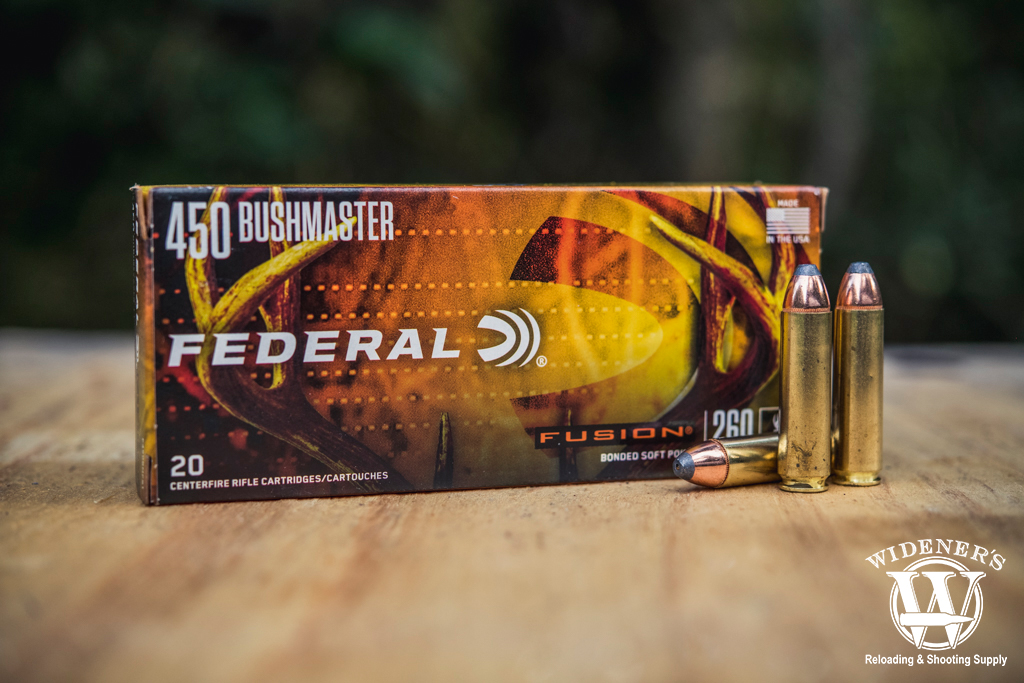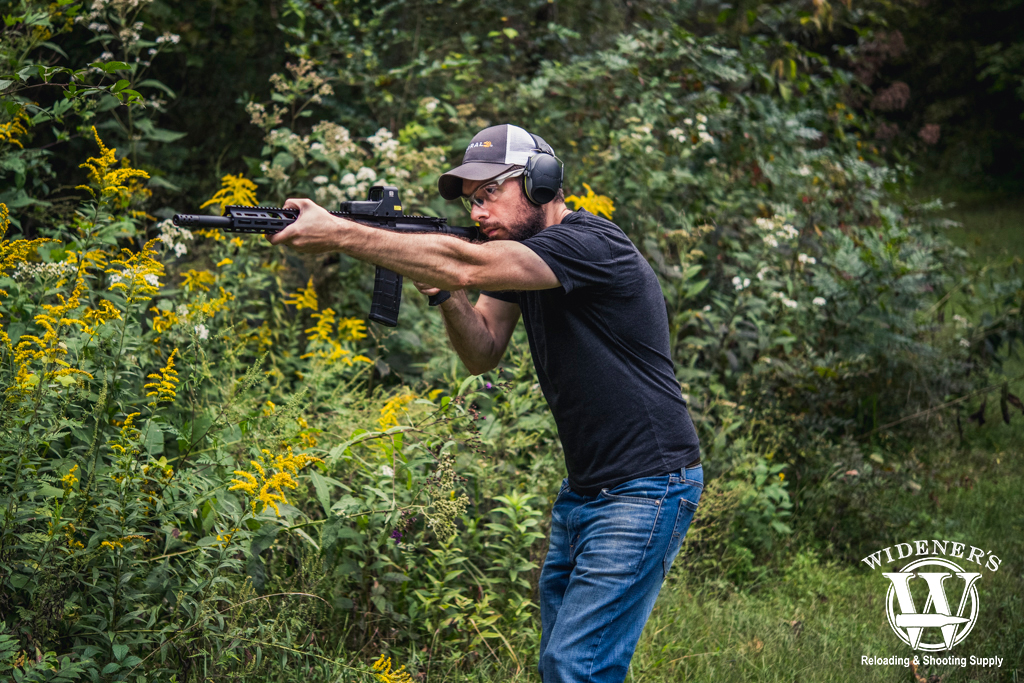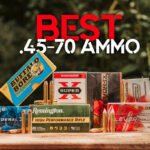

By Guy J. Sagi
The 45-70 Gov’t cartridge is over 140 years old and originally designed for the use of black powder as a propellant. This historical cartridge isn’t ready to be put out to pasture just yet. When stuffed with modern powder its performance rivals a much more modern ballistic invention. A bullet of nearly equal girth—the AR-15-friendly .450 Bushmaster.
Both centerfires are solid choices for taking big game at moderate range, and their looks are similar, but the differences are significant. Several key factors create distinct advantages and disadvantages. Here’s a quick rundown of the key considerations for 45-70 VS .450 Bushmaster if you’re looking for a new rifle in either chambering.
Similar Ideas, Not Identical

If you’re comparing 45-70 VS 450 Bushmaster, you may want to decide if you prefer a traditional or modern gun.
The .45-70 Gov’t and .450 Bushmaster are both called straight-walled cartridges. There is no taper toward the bullet, shoulder, neck, or other changes of direction in the case walls. There’s been a resurgence of interest in both because a number of states have now made the use of this style ammunition legal during big-game seasons (check local regulations).
The physical dimensions of each cartridge are far from identical, despite the resemblance. Case length in the Bushmaster is 1.7 inch, and the .45-70’s runs 2.105 inches. Also, the latter has a rimmed case and the former has a rebated rim—noticeable groove or slimming of the diameter above it.
There are other differences, but it all adds up to the fact that no gun can run both cartridges interchangeably. Standardized specifications from the Sporting Arms and Ammunition Manufacturers’ Institute prevent accidentally chambering the wrong ammunition.
45-70 VS 450 Bushmaster Advantages
That fact’s critical because the projectile diameter isn’t even identical between the cartridges, despite names that hint they are. Bullets for the .45-70 Gov’t measure .458 inch in diameter. This girth gives the elder statesman a decided advantage when it comes to loads available that improve the chances of delivering an ethical, one-shot stop during hunting seasons. Additionally, there are many different bullet weights and styles in that width.
Bullets for the .450 Bushmaster, on the other hand, have the same diameter as those used in .45 ACP handguns—.452 inch. Those pistol projectile weights and profiles predominated the cartridge’s loadings at first, although more hunting-friendly designs appear often now.
.450 Bushmaster Ammo

Federal Fusion 450 Bushmaster 260gr is a bonded soft point ammo designed specifically for hunting.
Col. Jeff Cooper—the widely acknowledged expert who brought self-defense firearm training to civilians by establishing what would become Gunsite Academy—was a big proponent of .44-bore or larger guns for their one-shot-stop potential. It was a well-known fact he didn’t like the effectiveness of .223 Rem and 5.56 NATO when delivered from AR-15s.
That caught the attention of Tim LeGendre, of LeMag Firearms. He developed a “.45” cartridge that would run reliably in an AR-15. When he presented it to Cooper, along with a suitably chambered carbine, he called the ammo .45 Professional. Bushmaster later licensed it and in 2007 enthusiasts caught their first glimpse of the .450 Bushmaster.
A variety of companies manufacture rifles that digest the cartridge. It thrives in the modern sporting rifles category and has invaded bolt-action territory and even lever actions. Also, if you look hard enough, you can find the rifle you’ve been dreaming of. There’s something in the big-bore category for everyone.
.45-70 Gov’t Ammo

Hornady Lever Evolution 45-70 250gr ammo is designed to provide increased expansion and downrange performance.
The U.S. Army adopted the .45-70 Gov’t cartridge in 1873 for use in its Trap Door Springfield rifles. Loaded with black powder it ran well enough in the single shots to remain the military’s official ammo for 19 years.
Even then, the government wasn’t in a hurry to ditch the ammo and guns. The firearms and cartridges used by U.S. volunteer regiments during the Spanish-American War were all chambered in .45-70 Gov’t, with the notable exception of Teddy Roosevelt’s Rough Riders.
It grew particularly popular with hunters and other civilian sportsmen after smokeless powder replaced the traditional black powder propellant. More fashionable cartridges—like the 1906 introduction of the .30-’06 Sprg.—took a big chunk of market share, though. But, by sometime in the 1930s American rifle manufacturers stopped producing firearms for the chambering, according to “Cartridges of the World, 4th Edition” by Frank C. Barnes.
It never fully disappeared and has made a steady comeback. Today you can find it in new bolt- and lever-action guns. Unfortunately, it does not run in modern sporting rifles, although a few companies modified the casing’s rim to accomplish the feat.
Keep in mind, too, that the older rifles designed for black powder loads cannot use all cartridges loaded with smokeless powder safely. Additionally, the increased pressure can lead to catastrophic failures and injury. There are, however, popular alternatives used regularly for cowboy action shooting competitions. A fun competition shooting category where this popular cartridge will never fall out of grace.
Big Bore Trajectory
Both cartridges have the kind of arching trajectory that limits effective range. Of course, with bullets of this diameter, the primary mission is taking down big game—including bears—from up close and personal to out at medium distances.
Federal’s Fusion hunting loads illustrate the arching trajectory. Its .45-70 Gov’t 300-grain load, zeroed at 100 yards, drops 41.8 inches at 300. Move the gun’s zero out the 200 yards and at 500 the holdover is a whopping 148.5 inches.
| .45-70 Gov’t Federal Fusion 300gr (Zeroed @100 Yards) | 100 Yards | 200 Yards | 300 Yards |
|---|---|---|---|
| Bullet Drop Trajectory | 0″ | 11.9″ | 41.8″ |
In .450 Bushmaster, a 260-grain bullet, again a Fusion, zeroed at 100 yards drops 37.1 at 100 yards. Push zero out to 200 and holdover at 500 is even worse, 152.8 inches.
| 450 Bushmaster Federal Fusion 260gr (Zeroed @100 Yards) | 100 Yards | 200 Yards | 300 Yards |
|---|---|---|---|
| Bullet Drop Trajectory | 0″ | 9.7″ | 37.1″ |
Muzzle Velocities
The Bushmaster gets the nod in cartridge pressure, with the ability to hold 38,500 PSI. The 45-70 isn’t too far behind, topping out at 28,000 PSI. Muzzle velocities are another interesting juxtaposition between the two cartridges. 450 Bushmaster velocities hang in the 2,200 FPS range and max out somewhere around 2,800 FPS depending on the load.
| 450 Bushmaster | Muzzle Velocity | Muzzle Energy |
|---|---|---|
| Hornady 250gr FTX Poly Tip | 2200 | 2687 |
| Federal 260gr Fusion BSP | 2200 | 2794 |
| Federal 300gr Power Shok JHP | 1900 | 2405 |
Modern 45-70 cartridges are in the 1,850 FPS range on average, but some high-pressure hunting loads can reach over 2,700 FPS.
| 45-70 Gov’t | Muzzle Velocity | Muzzle Energy |
|---|---|---|
| Hornady 250gr Monoflex Tip | 2025 | 2276 |
| Winchester 300gr Super-X JHP | 1880 | 2355 |
| Black Hills 405gr FPL | 1250 | 1405 |
That’s game-stopping power in both cases. Compare those figures to Federal’s 62-grain Fusion 223 Rem bullet and it’s obvious the Bushmaster answers Cooper’s call for an up-close fight-stopping cartridge that runs in a semi-auto rifle. It leaves the gun at a scalding 3,000 fps, but generates only 1,239 foot-pounds of energy.
45-70 VS 450 Bushmaster: Bullet Types
Between the two cartridges, the .45-70 Gov’t offers the widest variety of bullet weights in commercially available offerings. You can even find a few +P loads. Federal’s lineup currently sticks to 300-grain offerings. It includes options from the Fusion bullet, to a grain bonded soft point and jacketed soft point.
Bullet weights from other manufacturers run all the way from 225 grains to 500 grains. Manufacturers are also producing those lower-pressure, smokeless black powder-equivalent cartridges for cowboy action enthusiasts or those lucky enough to be running family heirlooms.
Bullet styles include those Fusions, lead round nose, Barnes TSX hollow points, Remington HTP Copper, hollow points, Hornady LEVERRevolution FTX, lead flat nose, and many more. If options are the spice of life, it’s definitely tasty. Accordingly, it’s fun to decide what type of .45-70 Gov’t projectile you want to send downrange.
In .450 Bushmaster, Hornady makes a subsonic 395-grain load with its proven Sub-X bullet—the heaviest bullet we could find, although there’s no doubt new offerings appear with regularity. Projectile weights run from there all the way down to 158-grains. Options in bullet design include some cutting-edge versions. The Lehigh Penetrator is one modern example. There are also bonded soft points, jacketed soft points, hollow points, and even a frangible load (the 158-grainer).
When Bigger Is Better

Go big or go home? Big bore cartridges offer a lot of ballistic power for hunters and shooting enthusiasts.
You will pay more, on average, for .45-70 Gov’t ammunition than for .450 Bushmaster. The former, however, has more commercially produced cartridges available, and they feature a wider diversity of bullet designs. If you have confidence in a certain projectile for hunting, the odds are better you’ll find it in .45-70 Gov’t before you see it in .450 Bushmaster.
Both cartridges deliver nearly identical performance downrange and are suitable for hunting, where legal. They are ideal out to moderate distances and carry the kind of bulk known to bust through thick brush or takedown foes as big as bruins.
So, which one’s really the better chambering for your next rifle purchase? That, like all things gun, comes down to personal preference.
If that gun’s going to do double duty as part of your home-defense plan, Col. Cooper’s wisdom is hard to ignore. Accordingly, many of the loads available fulfill that mission. The AR platform has literally thousands of compatible accessories available on the market.
Of course, if you’re among those who have a touch of Cowboy spirit, a lever-action looks mighty nice on your saddle. If you need a rifle capable of delivering one-shot stops, that .45-70 Gov’t. is hard to beat. And thanks to modern powder and bullet design, there are good reasons it has staged a comeback.
Either way, you can’t go wrong.


